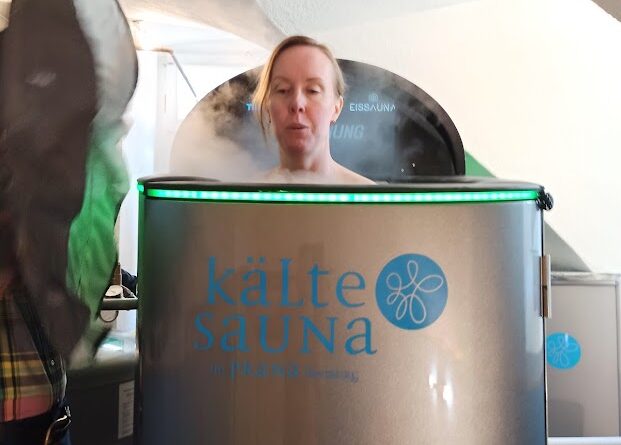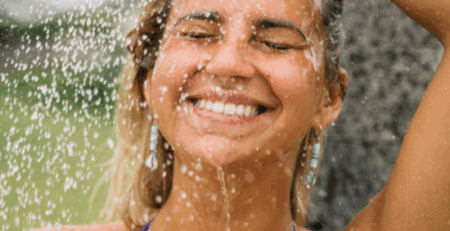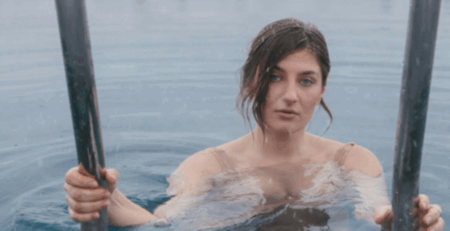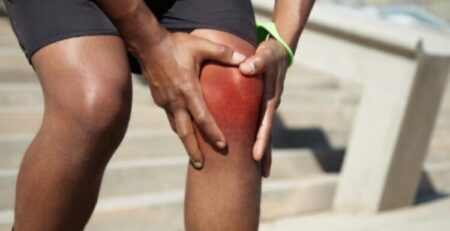Cryotherapy is a relatively new form of cold plunging in a controlled environment, which is why we wanted to take a closer look at it. We highlighted the differences between a cold plunge and cryotherapy and went into depth about individual aspects such as costs, clothing, and how the cold sauna works.
Table of Contents
What Exactly is Cryotherapy?
Cryotherapy (also known as cold therapy or cold chamber therapy) is a cold treatment similar to cold plunging. Kryos stands for ice or frost in ancient Greek. Cryotherapy, therefore, refers to the use of cold to treat various illnesses or ailments. The body is exposed to temperatures as low as -196 °C for a short period of time.
What Types of Cryotherapy are There?
There are various types of cold applications that are used as part of cryotherapy, including
- Whole-body cryotherapy: In this form of cryotherapy, the patient’s body is exposed to an extremely cold environment for a short time in a special room or chamber. The temperature can drop to between -140°C and -196°C.
- Partial cryotherapy: This form of cryotherapy can be applied either locally (to a specific part of the body) or regionally (to a specific area of the body). The body tissue is treated with a cold source such as ice packs, cold water, or cold spray.
- Cryosurgery: This is a procedure in which tissue is destroyed by freezing. This procedure is used to treat skin lesions or tumors.
What is the Importance of Cold Therapy?
Very similar in principle to cold plunging, cryotherapy is often used to relieve pain, reduce inflammation, improve circulation, and strengthen the immune system. It can be applied locally to specific areas of the body or to the whole body. Here is also an overview of the benefits of cold plunging.
Cryotherapy is usually carried out by specially trained medical staff and requires careful monitoring of the patient to ensure that no damage is caused by the extreme cold.
What is the Difference Between a Cold Sauna and Cold Plunging?
Both the cold sauna and cold plunging are cold therapies based on similar physiological mechanisms. However, the main difference between the two is the way in which the body is exposed to the cold.
In a cold plunge, the body is completely immersed in ice water at temperatures between 0 and 10 degrees Celsius. The body is thus cooled evenly from all sides, which leads to rapid cooling and slows down blood circulation. The cold can also be uncomfortable and can lead to trembling and muscle stiffness.
A cold sauna, on the other hand, is a dry environment in which the body is cooled from the outside by cold air. The cold is generated by a special cooling system and cooled down to a temperature of -160 degrees Celsius. The cold is applied to the body evenly and in a controlled manner, reducing cold pain and shivering. In addition, the head can be seen out of the sauna, which prevents a feeling of confinement.
Another difference is the duration of exposure to the cold. While a typical cold plunge lasts about 3-10 minutes, depending on the coldness of the water, a cold session usually lasts only 2-3 minutes. The short duration reduces the risk of frostbite or other cold injuries.
Overall, the cold sauna is a popular choice for many people, especially athletes and people looking for a quick recovery from physical ailments or injuries, due to its controlled cold application and shorter duration compared to a cold plunge.
It is also independent of the weather, making it a good addition to cold plunging in summer.
Direct Comparison Between Cold Plunging and Cryotherapy
| Cold Plunging | Cryotherapy |
| Cold water – can be unpleasant | Cold air – easier to bear |
| Shock at the beginning when you get into the ice bathtub | Gradual increase in cold |
| Can only be practiced outdoors in winter | Accessible at any time |
| No additional costs | Costs per treatment up to EUR 50 |
| No supervision | Supervision by medically trained staff |
| Warming up takes longer | Very short warm-up time |
| Swimsuit necessary | Sufficient underwear |
| Entry can be difficult | Easy to use |
| 2-10 minutes Duration | 2-3 minutes duration |
How the Cold Sauna or Cryochamber Work Technically
A cryochamber, also known as a cryosauna, is a device designed to treat the body with extremely low temperatures. The cryochamber consists of a closed cabin that is filled with refrigerants such as liquid nitrogen or a stream of cool air. This allows the temperature to be lowered considerably in a very short time.

The Cryosense cold sauna is one of the best-known and most advanced cold saunas on the market, offering a variety of settings to tailor the treatment to the user’s individual needs and preferences. The chamber is also equipped with safety features such as an emergency stop button and an open window to ensure the user remains safe during treatment.
The Cryosense cold sauna works with a closed refrigeration circuit and uses liquid nitrogen as a refrigerant to generate temperatures of up to -196°C. In the cabin, the nitrogen is vaporized into gas, which then cools the room. The Cryosense’s cold chamber design ensures that the cold is evenly distributed around the body.
Another feature is the precise control of the temperature and session duration using a computerized control system. The cold sauna is also equipped with sensors and safety systems to ensure that the session is safe and effective.
The cold chamber enables faster cooling and offers a higher cooling intensity than conventional cold therapy methods such as ice compresses or cold tubs. The short duration of the cold session (2-3 minutes) and the use of dry cold gas also minimize the risk of skin injury or frostbite that can occur with prolonged exposure to cold.
Overall, cold saunas offer a wide range of functions that can be individually tailored to the user’s needs, such as aroma, music, color therapy, and much more.
What Do You Wear in the Cryo Chamber?
The cryochamber, which actually looks like a tall barrel, is only entered with minimal clothing. You only wear your underwear and thick socks. Optionally, you can also put on gloves.

Your head remains outside, and you are fitted with an oversized neck brace to prevent the cold nitrogen from escaping upwards.

What Does a Cold Therapy Session Cost?
This is probably relatively different. The cost of a visit to the cold chamber at Prana was €39, which is only €29 per treatment if you buy a ten-ticket. In this respect, it is really affordable, as a lot of energy goes into the cooling in the form of nitrogen.
When Does Health Insurance Cover Cryptotherapy?
The health insurance company can pay for cold therapy under certain circumstances. However, the treatment is usually only reimbursed if it is medically necessary and prescribed by a doctor. Some of the medical conditions for which cold therapy is considered effective and may be reimbursed by health insurance are:
- Rheumatoid arthritis
- Multiple sclerosis
- Fibromyalgia
- Psoriatic arthritis
- Ankylosing spondylitis
- Sports injuries
In some cases, cold therapy can also be used as a complementary therapy in cancer treatment to reduce the side effects of chemotherapy and radiotherapy.
The cryochamber is often used as an alternative to cold plunge therapy or as a complementary therapy for athletes, to relieve pain, improve sleep, fight inflammation, increase collagen production, or improve general well-being. However, it is important to note that it may not be suitable for certain groups of people, such as those with certain medical conditions, and it is important to consult a doctor before use.
How Long Does A Cryptotherapy Session Take?
The treatment usually only takes 2-3 minutes. During this time, the person’s body is cooled down very quickly to low temperatures of -140°C to -196°C. This causes the blood vessels to contract. This leads to a contraction of the blood vessels. After the treatment, the person usually enters a relaxation room to warm up.
Interview With Sven Kühnöl from the Prana Freiburg health practice and Self-test in the Cryochamber
So much for the theory, but how does cryotherapy work in practice, you ask? To find out, I interviewed Prana Freiburg, a health practice offering a range of treatments from cryotherapy to the salt room. Here’s the full interview:
Constantin (Eisbaden.de):
Hello friends of the cold, I’m Constantin, the Chief Ice Officer of Eisbaden.de, and I’m always dealing with topics like cold, exposure, sauna, cryotherapy, and much more. Here in Freiburg, it’s already 25 degrees outside, but last weekend we were with our group at the local river Dreisam, where the water was only 11 degrees. So in summer, we have to think about what we want to do if we want to go swimming. That’s why I’ve been invited here today by Sven Kühnöl from Prana Freiburg. Sven is the managing director and has a great cold sauna here in the background. Sven, could you please briefly introduce yourself and tell us something about Prana? How long has Prana been around?
Sven Kühnöl:
Yes, thank you, Constantin. We have had Prana since January 2009. I am a non-medical practitioner for psychotherapy and specialize in talk therapy and Ayurveda. I have also been teaching at the Freiburg Heilpraktikerschule for a long time. Among other things, we offer floating and hypnosis, which have also been scientifically studied. I opted for cold therapy in 2019 because it fits in very well with our overall concept. People go into a float cabin after the cold sauna. I use this as a hypnotic suggestion after hypnosis so that when they go into the cold afterwards, their wishes are fulfilled, and it’s much easier to stop smoking. It simply fits wonderfully into our overall concept.
Constantin (Eisbaden.de):
That sounds exciting. Several components of the therapy are part of it. Of course, we are particularly interested in the cold sauna and cold exposure. Could you please briefly tell us something about the cold sauna? How does it work technically? How cold is it in the sauna? We will also be testing it live later, but it would be interesting to know what happens inside.
Sven Kühnöl:
So, we bought a Kryon in 2019, a sauna from St. Petersburg. They also invented it because it was discovered in Russia. We installed a cooling system that requires four liters of nitrogen for pre-treatment and then another four to five liters for the main application. This is now a Spanish model equipped with the latest cooling technology. You can simply start the cold sauna, and the cold is available after just 30 seconds, down to a maximum of -196 degrees, which is what the liquid nitrogen provides. Liquid nitrogen still has a temperature of 196 degrees, and you can fill 530 liters of nitrogen into the tank. This may be enough for around 35 applications, depending on utilization and outside temperature. Even that is an expensive affair. Nitrogen is present in 79% of our ambient air. If you’re asking if it’s a green gas, yes, it is. This gorgeous Spanish model has a very large interior and also works with heat. First, you are treated with one minute of heat to warm up the body to 80 degrees so that the vessels expand.
Sven Kühnöl
Then it goes down to -188 degrees Celsius in 30 seconds, which is the program that saves the most money. Then you stay in for a full 180 seconds and can get out at any time. The cold therapy lasts 2 to 3 minutes, but most people stay in for 3 minutes in the first application, and usually only do up to 172 degrees.
Constantin (Eisbaden.de)
Yes, it sounds very interesting. So at first glance, it looks different from ice bathing. When I do cold plunging, I have a body temperature of 36-37 degrees and go into water that is about 5 degrees cold, so a temperature difference of about 32 degrees. Here we have a difference of 280 degrees, from 80 degrees to -200 degrees. Is that something else? How do you cope with these large temperature differences?
Sven Kühnöl:
Yes, I often hear that this is the luxury version of cold plunging. The nitrogen creates completely dry, cold air. It feels like an ice-cold wind that washes over you, similar to a cold plunge. When I do it myself, I can also feel the lack of air. You have to hold out for 30 seconds. This is more pleasant, despite the lower temperatures, because the ice-cold water sticks directly to your body and you can form a thermal bridge. But once the air comes in, it no longer hurts here. The icy cold wind sinks you slowly and deeply. The skin also gets colder, the core temperature drops by a maximum of one and a half degrees, and it feels much more pleasant than cold plunging. As a result, there is a clientele here who find cold plunging too inconvenient and prefer the luxury option. The former therapy with nitrogen is no better or worse than plunging, and it is understood.
Constantin (Eisbaden.de):
Yes, as a cold water swimmer, I brought a towel and normal swimming trunks, of course, but I could actually do without all that.
Sven Kühnöl:
First, you put on a pair of underpants here and then some fun stuff on top. If necessary, we also put on gloves to protect the toes and fingertips, as there are fine capillaries in them that often need to be protected from tangles. Otherwise, you stay pretty dry here. You won’t be dry afterwards, but your skin will look great.
Constantin (Eisbaden.de):
And it’s also a controlled environment. That means I’m not alone, and even if I don’t have anyone with me, it’s not a safety risk. If something happens in the water…
Sven Kühnöl:
I’m there all the time and look you in the eye to see how you’re doing. If you have any doubts, I just press a button and open the door, and you can sit down on the sofa. That’s why everything is written here.
Constantin (Eisbaden.de):
What about the cost of the cold application? If you do one session or several sessions in a row or combine it with something else, what about the costs?
Sven Kühnöl:
A single treatment costs €39 because the nitrogen is so expensive. People who come more often often buy a ten-ticket, which only costs €29 per treatment. When we buy nitrogen, it comes in a special tanker from Donaueschingen, and it’s all very complex and expensive, but it fits into our overall concept. We don’t earn very much with it, but it fits in wonderfully, and I like to go in two or three times a week myself. The expensive thing is the nitrogen.
Constantin (Eisbaden.de):
Yes, exactly. And it is also possible, as we were told in our first conversation, that the health insurance company can cover certain parts if it actually takes place as part of a therapy.
Sven Kühnöl
Exactly. The GP can prescribe therapy in ten or 18 blocks, as I’ve heard so far. This varies depending on the GP and health insurance company. I try to give tips, but everyone has to sort out the billing for themselves with their GP and health insurance company. Anyone who comes to us simply has to pay for the treatment. You can’t submit a prescription and then just try it. You have to bill for it. It’s not that complicated. But we have a lot of people, mainly rheumatism, arthritis, and pain patients, who are prescribed it. Also, people with post-COVID fatigue syndrome. They simply benefit from the cold. They have a much better quality of life. I’m at the back of the queue. From a scientific point of view, there are also studies. But if you don’t have a lobby, you don’t get enough money to carry out scientific studies.
Constantin (Eisbaden.de)
Yes, that’s exactly right. Studies and counter-studies partly prove the effect, but not for other applications. There is still a lot of hidden information that needs to be researched. But everyone can find out for themselves whether the cold bath really helps. Sometimes you also get better results in terms of the skin, and it has many positive benefits that you can feel immediately. I don’t need 37 studies on ice baths for that. We have also published a few studies that were carried out by universities. But in principle, everyone can immediately notice in their own body how vital and energized they feel.
Sven Kühnöl
Cold applications are clearly anti-inflammatory and also have an effect on different areas of inflammation in the body. Long Covid has also shown, among other things, that exposure to cold helps. This anti-inflammatory effect can mean that people can reduce their cortisone dose by half in consultation with their GP. There are such cases, and that’s fine.
Conclusion
Cryotherapy and cold water plunging share the same foundation: using extreme cold to improve health, recovery, and resilience. While cold plunging relies on water immersion and is cost-effective and easy to do at home, cryotherapy offers a controlled, professional setting with ultra-low temperatures and shorter session times. Both methods provide benefits, including reducing inflammation, boosting circulation, and strengthening the immune system, making them valuable tools for physical and mental well-being.
My interview with Sven Kühnöl at Prana Freiburg added a real-world perspective, showing how cryotherapy is applied in practice. His expertise, combined with the self-test experience in the cold sauna, highlighted the practicality, safety, and surprising comfort of cryotherapy compared to traditional cold plunging.








Leave a Reply